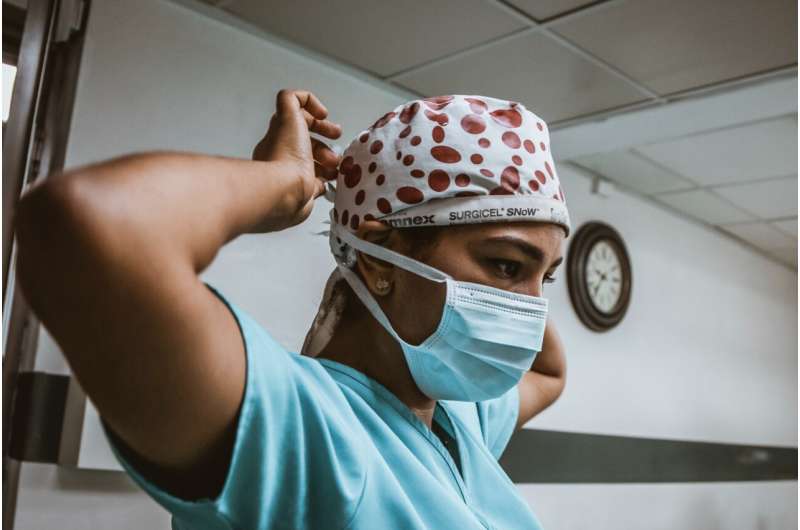
Credit: Unsplash/CC0 Public Domain
A new study published in the American Journal of Infection Control (AJIC), based on a survey of health care professionals conducted during the height of the COVID-19 pandemic, suggests that new efforts may be needed to strengthen infection prevention precautions and protect staff members at the highest risk of exposure to dangerous pathogens.
This is believed to be the first study of pandemic-era infection precautions to include a broad variety of health care jobs. Researchers found that workers who had the highest risk of exposure to SARS-CoV-2 were also the most likely to report errors in their own adherence to infection prevention measures.
Many infection prevention studies have been performed to understand how health care professionals’ compliance with precaution guidelines held up during the COVID-19 pandemic, but until now most of those studies have focused on physicians and nurses.
This new study expands on that body of research by including other members of the health care profession who experienced exposure risk, including respiratory, physical, and speech therapists; food services; environmental services; and clinical dietitians. Typical infection prevention and control measures include practices such as hand hygiene and the use of personal protective equipment (PPE) such as masks, gloves, and gowns.
For this study, researchers analyzed responses to surveys from 191 health care personnel at the University of North Carolina Medical Center. Participants were enrolled between July 2020 and January 2021 and were asked to report their experiences in SARS-CoV-2 exposure and adherence or non-adherence to infection precaution protocols.
Respondents were grouped into three broad categories: physicians, advanced practice providers, physician assistants, and nurse practitioners (45%); registered nurses (27%); and other, which included therapists, dietitians, and members of food and environmental services (28%). In addition to the self-reported survey data, study researchers also routinely observed health care staff and monitored their compliance with infection precautions to collect validation data. Generally, the trends reported in survey responses and by the observers was concordant.
Data analysis showed statistically significant differences between job role, risk of potential exposure to SARS-CoV-2, and likelihood of making errors in infection precaution adherence. For example, 57.4% of registered nurses completed job tasks that placed them at a higher risk of SARS-CoV-2 exposure, compared to nearly 29% of physicians and 38% of the “other” category.
Health care personnel who were more likely to be exposed to the virus were also 5.74 times more likely to report at least one error in infection precautions in the previous two weeks, such as failure to don protective gear.
“While error rates varied by job type, what this study really shows is that all three groups of health care personnel were at risk of SARS-CoV-2 exposure and were making errors in adherence to infection prevention protocols during the height of the pandemic,” said Emily J. Haas, Ph.D., a research health scientist at the Centers for Disease Control and Prevention’s National Institute for Occupational Safety and Health and National Personal Protective Technology Laboratory, and lead author of the study.
“This is a clear demonstration that we need to improve engagement in our training for emergency preparedness and to create a more strategic response that will help our health care workers stay safe even in times of extreme stress.”
In this study, researchers also found that:
Adherence to PPE guidelines varied by job type: more registered nurses (33.3%) and physicians (26.5%) reported at least one error in the previous two weeks than those in the “other” category (9.6%).Respondents reported reliable access to PPE, with most saying they always had access to gowns (93%), gloves (99%), eye shields (98%), and face masks (98%).Hand hygiene was the infection precaution most frequently performed incorrectly, with study observers noting that hand and glove hygiene protocols were only adhered to 40% of the time between visits to rooms with patients who had COVID-19.
“This study adds to our understanding of health care personnel compliance with infection prevention protocols during COVID-19 and highlights improvement opportunities,” said Patricia Jackson, RN, BSN, MA, CIC, FAPIC, 2023 APIC president.
“Infection preventionists can use this information in their education and outreach to strengthen preparedness for future outbreaks and to improve the safety of the day-to-day delivery of health care.”
More information:
Emily J. Haas et al, Infection precaution adherence varies by potential exposure risks to SARS-CoV-2 and job role: findings from a U.S. medical center, American Journal of Infection Control (2023). DOI: 10.1016/j.ajic.2023.10.010
Provided by
Association for Professionals in Infection Control
Citation:
COVID-19 pandemic study shows adherence to infection precaution measures among health care personnel varies by job role (2023, December 7)
retrieved 7 December 2023
from https://medicalxpress.com/news/2023-12-covid-pandemic-adherence-infection-precaution.html
This document is subject to copyright. Apart from any fair dealing for the purpose of private study or research, no
part may be reproduced without the written permission. The content is provided for information purposes only.
>>> Read full article>>>
Copyright for syndicated content belongs to the linked Source : Medical Xpress – https://medicalxpress.com/news/2023-12-covid-pandemic-adherence-infection-precaution.html































